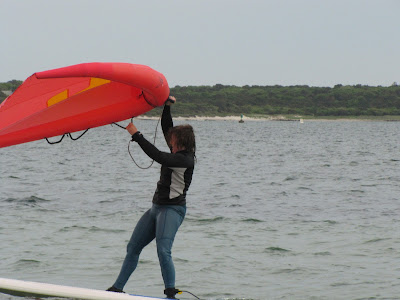There were a few upwind walks involved in this session.
A few days later, the fuselage on my foil snapped mid-session. I had added an extra hole so that I could move the wing more forward on my old slalom board. That gave me a much more balanced setup, and worked fine for about 50 sessions. But it left one extra hole between the front wing and the mast, and that's were the fuse broke. A trip to Inland Sea in West Dennis later, I had a new fuselage - and a JP SUP that's well suited for wing foiling.
Since then, Nina has been winging three times. The first session was in 25 mph averages on my old Skate 110, and she managed to get up on the foil a few times. That was a success.
Nina's second wing foiling session was at in lighter wind at Pleasant Bay. This one was bit more frustrating, with only short runs on the foil and not much progress. But we saw Jerry Evans on his setup, which was pretty impressive. I was barely able to get up on the foil on my 5.0 m sail, but Jerry was foiling the entire time on his 4.2 m wing. He was also having a total blast. One of the things I had read about winging was that wing foiling needed more wind that wind foiling - but that clearly was not the case here.
The next few days saw lighter wind, which Nina used to foil on the new JP SUP with a rig. That was a worth-while exercise, since the board behaves quite differently from our windsurf boards. The foil is further forward under the board, the mast base is further back, and the board is shorter, has round rails, and a lot of rocker. That means the technique to get going is surprisingly different. Any sideways pressure while pumping quickly results in a direction change, so I had a hard time to get the board accelerate to take-off speed in light wind. But Nina figured it out, and managed to foil in 11-12 mph wind with her 5.2 sail.
Her third day of wing foiling was in 16-22 mph averages at Kalmus. The progress was quite astonishing - she was always foiling, apparently 100% in control, when going out against the waves, and often also when coming back to shore. That's a bit more difficult even when foiling with a windsurf rig, since the waves coming from behind affect the large 84 cm foil a lot, pushing it up and down. But at the end of the session, even her inbound runs look about as good as my windfoiling runs (after ~80 sessions so far). She even got a few dry jibes, although not yet foiled through.
What amazed me most about her three sessions was the range of the wing. The same 4.2 m wing worked perfectly fine in 16 mph averages and in 30 mph gusts. With windsurfing sails, the same range would typically require 3 different sizes - at least. Windfoiling, I could probably get away with just one sail (a 5.0), but the 16 mph are close to the low end, and in 30 mph gusts, things would start to get quite "interesting", and crashes would become more frequent. But on the wing, Nina felt perfectly comfortable over the entire range. Power can be controlled very easily with the wing, it seems - and since the power is not transmitted over the rig towards the front of the board, adjusting power does not lead to the board going up or down, which tends to happen when sheeting out or in while windfoiling.
So at some point in the future, I'll probably have to try this wing thing myself. I don't think it will happen with the 4.2 wing - I'd need a lot of wind, which would also mean a lot of chop at Kalmus, so I'd just be falling off the board all the time. But besides that, Nina would want to use the wing herself, and preferably with the JP SUP (at least until she gets better and may want a much smaller board). So we'll probably have to wait until we get a second wing - a bigger one for Nina's light wind fun, and for me in somewhat stronger winds.
